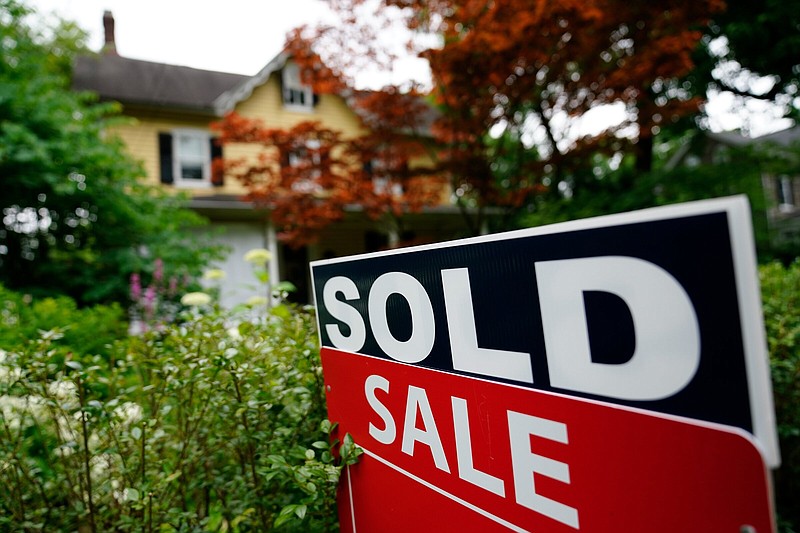Sales of previously owned U.S. homes slowed for the fifth consecutive month in June as higher mortgage rates and rising prices kept many home hunters on the sidelines.
Home sales, excluding new homes, fell 5.4% last month from May to a seasonally adjusted annual rate of 5.12 million, the National Association of Realtors said Wednesday.
That's lower than the 5.37 million home sales pace economists were expecting, according to FactSet. Sales fell 14.2% from June last year.
After climbing to a 6.49 million annual rate in January, sales have fallen to the slowest pace since June 2020, near the start of the pandemic, when they were running at an annualized rate of 4.77 million homes. Excluding the pandemic-related slowdown, sales in June were running at the slowest pace since January 2019.
Even as home sales slowed, home prices kept climbing in June. The national median home price jumped 13.4% in June from a year earlier to $416,000. That's an all-time high according to data going back to 1999, the realtors association said. Despite the increase, home prices are not climbing as much as they were earlier this year.
"With each passing month it appears price appreciation is less strong than earlier months," said Lawrence Yun, the National Association of Realtor's chief economist.
The June sales report is the late evidence that the housing market, a key driver of economic growth, is slowing as homebuyers grapple with sharply higher mortgage rates than a year ago.
"A combination of higher prices and higher mortgage rates clearly has shifted the dynamics in the housing market," Yun said. "Home sales will only begin to stabilize once mortgage rates begin to stabilize."
The average rate on a 30-year fixed-rate home loan climbed to 5.51% last week, according to mortgage buyer Freddie Mac. A year ago it averaged 2.88%.
Mortgage rates have been climbing in response to a sharp increase in 10-year Treasury yields, reflecting expectations of higher interest rates overall as the Federal Reserve raises its benchmark rate in a bid to quell the highest inflation in decades.
Even with higher mortgage rates straining affordability, homes that sold didn't stay on the market for long. On average, homes sold in just 14 days of hitting the market last month, the fastest sales pace tracked by the National Association of Realtors. It was 16 days in May. Before the pandemic, homes typically sold more than 30 days after being listed for sale.
House hunters able to navigate the effects of higher mortgage rates had a wider selection of homes to choose from last month, at least. The number of properties for sale jumped 9.6% from May to 1.26 million, and rose 2.4% from June last year -- the first annual increase in three years, Yun said.
Still, at the current sales pace, the level of for-sale properties amounts to a 3-month supply, the realtors association said. That's up from 2.6 months in May, and 2.5 months a year ago. That's still short of the 5- to 6-month supply that reflects a more balanced market between buyers and sellers.
Despite the still-tight supply of homes for sale, rising mortgage rates and prices, first-time buyers accounted for 30% of sales last month, the realtors association said. That's up from 27% in May, but still low by historical standards, when first-time buyers made up as much as 40% or more of transactions. Real estate investors and other buyers able to buy a house outright without financing accounted for 25% of all sales last month.
Housing affordability is set to worsen to levels last seen early in the financial crisis as rising mortgage rates compound high prices, according to S&P Global Ratings.
By the end of this year, mortgage payments will make up 28% of income for the typical first-time buyer -- the highest since the first quarter of 2007 -- assuming a 10% down payment, S&P North American Chief Economist Beth Ann Bovino said in a report. Mortgages shouldn't exceed 25% of income to be considered affordable, per National Association of Realtors' guidelines.
That threshold has already been breached for low- and middle-income buyers and will remain "well above" it through 2025, leaving 60% of U.S. households out of the market, S&P said.
"High home purchase prices don't necessarily mean that homes have become unaffordable, but after over a decade of relatively benign home purchase conditions, our analysis of housing market conditions shows affordability has worsened in recent years," the report said.
The housing market is coming off its boil as mortgage rates rise. That's crowding out buyers who were already struggling with record prices.
For prospective homebuyers, that means signing a contract could be decades away. By the fourth quarter of 2022, it'll take 11.3 years for a first-time buyer with median income to save for a 10% down payment, and twice as long for 20%, S&P said. Before the pandemic, each took half as long.
Information for this article was contributed by Maria Torres of Bloomberg News.
